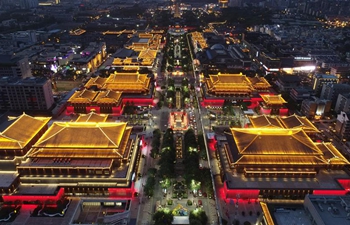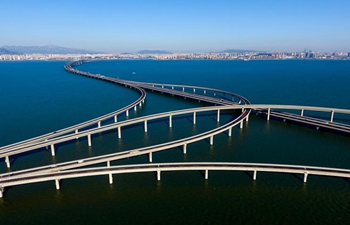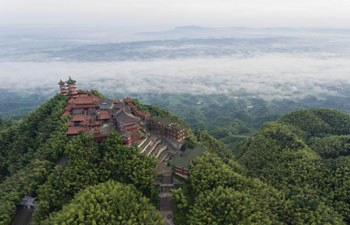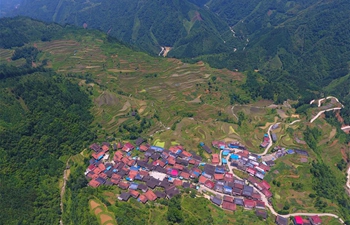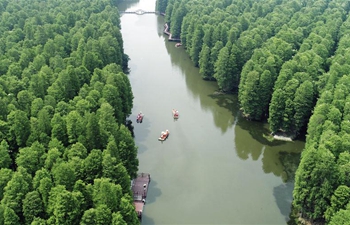
The breakwater of the Colombo Port City is seen under construction in Colombo, Sri Lanka, April 26, 2018. Spread over 269 hectares of land reclaimed from the sea adjacent to the present commercial district of Colombo, the Colombo Port City, co-developed by the Sri Lankan government and China's CHEC Port City Colombo (Pvt) Ltd under the Belt and Road Initiative, will in future become a commercial, financial, residential and international entertainment hub in the Indian Ocean region. TO GO WITH Feature: Story of stone in Colombo Port City (Xinhua)
by Zhu Ruiqing, Tang Lu
COLOMBO, June 10 (Xinhua) -- Since Sri Lanka entered its annual southwest monsoon season in May, the early morning rain has become a frequent visitor to capital Colombo.
Coupled with the rainfall, trucks carrying quarried stones are on their way from the outskirts of Colombo to the Port City's construction site.
During every weekday morning, a long queue of trucks waiting to be weighed has already lined up at the entrance of the construction site before 7:00 a.m. local time.
The size of stone carried by each truck varies. For Ekanayake, his job is to record the weight of the trucks and issue classification cards based on the size of loaded stones at the entrance.
"I've been doing this job for two years. With the help of my Chinese colleagues, right now I can accurately estimate the stone size just by eye," Ekanayake said proudly, sharing his working experience when his mobile phone begun buzzing.
"This is a group chat message from the Chinese mobile application, QQ. My colleagues just sent the test results of some early arrived stones. Today, our team is able not only to systematically classify the stone, but also to effectively monitor the quality of that," Ekanayake said while showing his phone to Xinhua's reporters.
Spread over 269 hectares of land reclaimed from the sea adjacent to the present commercial district of Colombo, the Colombo Port City, co-developed by the Sri Lankan government and China's CHEC Port City Colombo (Pvt) Ltd under the Belt and Road Initiative, will in future become a commercial, financial, residential and international entertainment hub in the Indian Ocean region.
In the eyes of Ekanayake's Chinese colleague, Cao Dong, Deputy Project Manager from China's CCCC Fourth Harbor Engineering Co., Ltd, the rocks arriving at the site daily, along with the yellow sea sand, is gradually turning the dream of building a world-class city in Sri Lanka into reality.
The trucks finally reached a specially designated storage yard where the quarried stones, each of the same size, are placed together. With the rumbling of excavators clearly heard in the yard, the stone heaps of different heights look similar to a chain of rugged dark-grey mountains.
Xu Jie, Project Manager Assistant from CCCC Fourth Harbor Engineering Co., Ltd told Xinhua, the quarried stones in the Colombo Port City project are assorted into 15 kinds, and the total requirement for the stones is about 3.3 million cubic meters.
However, with such a high demand, the construction team of the Colombo Port City was confronted with a great deal of difficulties in purchasing the stones when the project was launched years ago.
"The production capacity of local quarries is limited by the Sri Lankan Government out of concerns to protect the environment. In addition, projects like the Port City which needs such an amount of raw building material is very rare here. Therefore, finding adequate stones had been a big problem for a long time," Xu Jie said.
Xu Jie continued, "over the years, we have been to all the quarries within 80 km around Colombo. Nowadays, we are in stable partnership with over 10 stone suppliers, with around 500 trucks of stone arriving at the site everyday, from early morning to midnight. Out of the total 3.3 million cubic meters' requirement, 2.6 million has already been delivered."
During the monsoon season, the weather in Sri Lanka changes quite often. While the early morning drizzle had come to a halt and the sun came out brightly through the clouds, the morning trucks also started heading back.
In contrast with many other empty trucks leaving the yard, there were some trucks still fully loaded with large stones, which looked a little different.
Xu Jie explained that the trucks still loaded with stones were not from the quarries. They belonged to the Port City project. The stones carried were to be used in building the breakwater of the Port City.
Surprisingly, most of the stones in the Port City are all for breakwater-building purposes. In the southeast of the construction site, are berthed several bottom-dump barges on which quarried stones are stored.
Xu Jie said that to put it simply, the breakwater is made of stones which are cast into the sea by the bottom-dump barges. When the barge arrives at the specific spot in the sea, its bottom will be opened and then the stones will be dumped.
"Even though due to the heavy tides during the monsoon season, most of the breakwater construction has been suspended, we are still trying to do some work to strengthen the already built part when weather permits," Xu Jie explained about the construction progress while pointing at a sketch map, on which the curved breakwater is hugging the Port City's newly reclaimed land.
"The stones play an indispensable role in the construction of the Colombo Port City. For instance, the breakwater, which is made of the stones, guarantees the land reclamation against the erosion of the sea tides. It has become the lifeline of the project," Cao Jianlin, Project Manager from CCCC Fourth Harbor Engineering Co., Ltd said.
Cao added, "for me, it is truly an honor to be able to participate in writing the story of the stone in the Colombo Port City."





